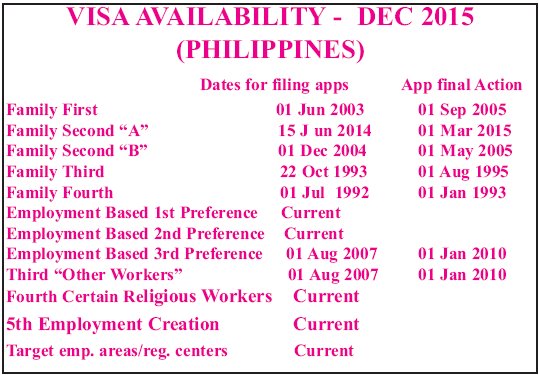By: Robert Gard
 President Obama’s Executive Actions — Status of Implementation & Political Infighting — Part 8 — Hope for Implementation is Fading Fast
President Obama’s Executive Actions — Status of Implementation & Political Infighting — Part 8 — Hope for Implementation is Fading Fast
Americans should not forget the party and the people who brought us to this grim situation. It was hard-core Republican nativists who repeatedly stymied comprehensive reform, most recently killing a bill that passed in the Senate in 2013 but died in the House. After the House failed to take up a bipartisan comprehensive immigration bill that had been approved in the Senate, President Obama felt that he had no choice but to use his executive authority to accomplish what he could to fix a long broken immigration system. Nearly a year ago, the Obama administration expanded protections to certain immigrants and their parents living here illegally. States, led by Texas, sued and won an initial victory to block implementation. The case is now stalled in the 5th Circuit Court of Appeals and some advocates suspect the court’s delay is deliberate.
Two key pieces (expanded “DACA” without age limits and “DAPA”) of President Obama’s Executive Actions Program, announced on November 20, 2014, were scheduled to go into effect on February 18th and May 26th of this year, respectively; but legal and political hurdles to implementation remain. On November 20, 2014, President Obama announced his “immigration accountability executive action,” which includes a series of measures that are first steps towards common-sense reforms to an outdated immigration system. The series of executive actions presented by the administration range from new temporary immigration protections for many unauthorized parents of U.S. citizens and lawful permanent residents to highly technical regulatory proposals to fix outdated visa provisions. The USCIS website has a DACA page/link, where the public can sign up for emailed instructions, updates and further developments: http://www.uscis.gov/immigrationact ion
As of the date of my last article on these issues (August), US District Court Judge Hanen (in Brownsville, Texas area) had issued a 123 page decision on February 16th, putting in place a preliminary injunction temporarily blocking implementation of President Obama’s new deferred action initiatives (expanded DACA and DAPA), while pointedly leaving the original 2012 version of DACA untouched and undisturbed. Judge Hanen indicated that his preliminary injunction was for the purpose of providing time for a coalition of 26 states to pursue a lawsuit seeking a permanent injunction against the President’s new deferred action initiatives. The Obama Administration filed an emergency Motion to remove the injunction ordered by Judge Hanen, and, on Tuesday, May 26th, a three judge panel of the U.S. 5th Circuit Court of Appeals, by a vote of two to one in what appeared to be an overtly politically influenced ruling, chose to leave Judge Hanen’s injunction in place, and the 5th Circuit then set a date of July 10, 2015 for a hearing on the full appeal. The full appeal was argued in the 5th Circuit before a panel of three Judges in July, two of whom had previously ruled against the Obama Administration on the previously argued emergency Motion. By most accounts, the session did not go well for the Obama Administration, though a final ruling has not yet been issued.
While the 5th Circuit normally issues decisions within about 60 days after oral argument, the 5th Circuit, in this case, still hasn’t issued their ruling and appears to be “slow-walking” the adjudication in order to run out the clock on the Obama Administration. The Obama Administration attorneys in the Department of Justice cannot appeal an adverse ruling of the 5th Circuit Court of Appeals to the U.S. Supreme Court until the 5th Circuit issues a ruling. By withholding their ruling, the 5th Circuit delays any appeal of their ruling to the Supreme Court, and any ultimate resolution of the issues. Even if the 5th Circuit were to issue its ruling (expected denial) next week, the Supreme Court would not issue a ruling on an appeal until June 2016 at the earliest. After the appeals court rules, attorneys for the 26 states who brought the law suit would have at least a month to file briefs, maybe more if they requested an extension. If the panel waits until late next month (Nov. 2015) to rule, it may be too late for the high court to hear the case this term.
If the case doesn’t get to the Supreme Court this “term,” the earliest ruling from the Supreme Court would be in June 2017, 6 months after President Obama leaves office. That timing would leave any final decision about immigration to Mr. Obama’s successor. “Each day that the court delays a ruling, it tears apart thousands of families and forces millions more to succumb to uncertainty. There are some who relish playing politics with the courts and people’s lives and are putting American values on hold,” said Angelica Salas, executive director of the Coalition for Humane Immigrant Rights of Los Angeles. Immigration activists have organized protests outside of the 5th Circuit Court of Appeals, but there has been no indication of an imminent decision in the case, and any hope of a positive immigration legacy for the Obama Administration is quickly slipping away. Obama’s executive actions have resounded on the presidential campaign trail, with most Republican candidates vowing to overturn them and Democrat Hillary Rodham Clinton strongly supporting them. Activists nationwide have mobilized to help immigrants apply for relief, if the legal stranglehold is ever broken.
Quick Notes: DHS to Create Filipino WWII Veterans Parole Program
The Department of Homeland Security (DHS) is creating a parole program to allow certain family members of Filipino and Filipino- American World War II veterans to receive parole to come to the United States. This parole program was announced in November 2014 by President Obama and Secretary Johnson as part of the executive actions on immigration and is detailed in the White House report, Modernizing and Streamlining Our Legal Immigration System for the 21st century, issued in July 2015. The program may enable these eligible family members to provide support and care to their aging veteran family members who are U.S. citizens or lawful permanent residents. Parole, as provided for under the Immigration and Nationality Act, gives DHS discretion, on a case by case basis, to permit individuals to come to the United States for a temporary period of time based upon urgent humanitarian reasons or for significant public benefit.
Parole does not give the individual any permanent right to remain in the United States. USCIS reminds customers that they cannot apply at this time. Any applications received before the program is implemented may be denied. We will inform the public when the application process is in place. Register to receive email updates. Please remember to be mindful of immigration scams. Visit www.uscis.gov/avoidscams, for tips on filing forms, reporting scams, and finding a licensed attorney or an accredited representative.
Healthcare Staffing Expected to Grow by 17% in 2016
Staffing Industry Analysts US Staffing Industry Forecast predicts that US healthcare staffing will grow by 17% in 2016. All four healthcare staffing sub-segments: – travel nursing, per diem nursing, locum tenens and allied health, showed double digit growth in 2015. Reasons for the increase in staffing are many, including tightening US labor supply and Obamacare allowing previously uninsured patients to avail themselves of healthcare services. More details on the report are accessible on their webpage.
Recent Changes for Immigrant Visa Processing at U.S. Embassy – Manila
· For a timely processing of your immigrant visa application, register your delivery address now! See Delivery Address Registration for details: http://www.ustraveldocs.com/ph/.
· Effective August 17, 2015, all Filipinos who hold an immigrant visa must reserve and register online before attending the Pre-Departure Orientation Seminar (PDOS) conducted by the Commission on Filipino Overseas (CFO) in Manila. Check CFO News for more information
When Does USCIS Require an I-824 to Take Action on an Approved I-140 or I-130 Immigrant Visa Petition?
If a petitioner indicates that the beneficiary will apply for a visa abroad at a U.S. Embassy or consulate on an I-140 petition (Page 2, Part 4, Question 1a) or an I-130 petition (Page 2, Part C, Question 22), the I-140 or I-130 petition will be transferred automatically to the National Visa Center (NVC) upon approval. If the beneficiary later decides to file for adjustment of status in the United States, the NVC will automatically transfer the approved I-140 or I-130 to USCIS when the Form I-485 is filed. Thus, an I-824 Application for Action on an Approved Application or Petition is not required when immigrant visa processing is indicated on the I-140 or I-130 petition. However, if a petitioner indicates that the beneficiary will apply for adjustment of status in the United States on the I-140 or I- 130 petition, the petition will be automatically transferred to the National Records Center (NRC) upon approval. If the beneficiary later decides to apply for an immigrant visa at a U.S. Embassy or consulate, an I-824 must be filed and approved before the petition will be transferred to the NVC to commence immigrant visa processing. Because I-824 processing times are lengthy and filing requires payment of a fee, practitioners should carefully consider the ramifications of indicating immigrant visa processing versus adjustment of status when completing Forms I-140 and I-130.
Rep. Paul Ryan: No Immigration Reform If He’s Speaker of the House
Rep. Ryan advised House colleagues that he will not bring an immigration bill to the House floor. He told his colleagues the issue was simply “too divisive” and he wanted to focus on the things on which the conference is in agreement, like border security and internal enforcement, as opposed to a comprehensive bill. What’s been mentioned less is what will happen when Obama is gone. ###
 VIA Times – November 2015 Issue Vital News, Vibrant Views for Asian Americans in Chicago & Midwest
VIA Times – November 2015 Issue Vital News, Vibrant Views for Asian Americans in Chicago & Midwest


